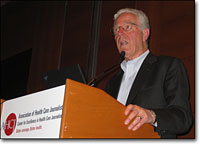Tag
Sarasota Health News
-
•
Reporters use county rankings for analysis
On Feb. 17, rankings of the relative health of counties in each American state were released by the Robert Wood…

-
•
Sarasota site hits milestone, wins unusual honor
It’s been three months since AHCJ member David Gulliver launched the nonprofit, online Sarasota Health News, and the site’s celebrating…

-
•
Under 1959 law, hospitals claim right to bill county for charity care
David Gulliver of Sarasota Health News found an almost-surreal local story that demonstrates just how desperate some recession-bitten hospitals have…

-
Primer on reform draws from AHCJ presentation
Sarasota Health News reporter and editor David Gulliver released his own evaluation of health care reform, drawing on the Dartmouth…

-
•
Novel H1N1 ‘remarkably similar’ to seasonal flu
Sarasota Health News editor and reporter David Gulliver talked to experts and listened to press conferences to produce a primer…

-
•
AHCJ member founds local health news site
AHCJ member Dave Gulliver, formerly of the Sarasota Herald-Tribune, launched the nonprofit Sarasota Health News late Wednesday night. In less…


